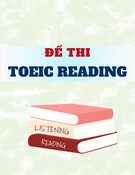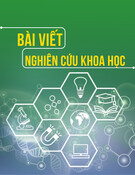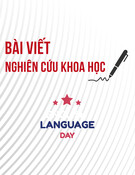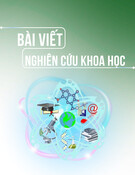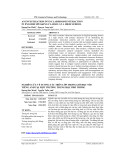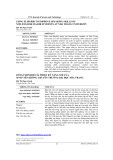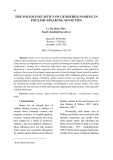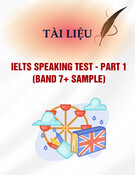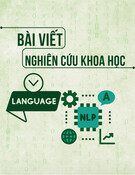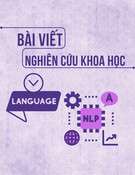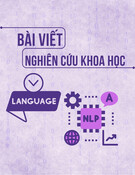
TNU Journal of Science and Technology
229(12): 03 - 10
http://jst.tnu.edu.vn 3 Email: jst@tnu.edu.vn
THE IMPACT OF UTILIZING EDUCATIONAL TECHNOLOGY TOOLS
ON IMPROVING THE SPEAKING PROFICIENCY OF ENGLISH
AS A FOREIGN LANGUAGE STUDENTS AT A UNIVERSITY IN VIETNAM
Nguyen Huu Hoang*
Academy of Journalism and Communication
ARTICLE INFO
ABSTRACT
Received:
18/01/2024
In this study, the efficacy of educational technology tools in enhancing
speaking skills was explored through a quasi-experimental design
involving 84 IT freshmen. Employing tools such as FORVO (FV),
YouGlish (YG), and Oxford Advanced Learners' Dictionary (OALD) 8th
edition, the research compared the speaking abilities of students using
these technologies (experimental group) against those taught through
traditional methods (control group). Data collection encompassed tests,
questionnaires, interviews, and instructor logs, with extensive sampling
used for student selection. Analysis through an independent samples T-
test and thematic analysis revealed that the experimental group showed
significant improvements in speaking fluency, coherence, accuracy,
vocabulary range, grammatical structure, and pronunciation. Additionally,
these students displayed positive attitudes towards using speaking
technology tools. These findings suggest the potential of integrating
technology in language learning, emphasizing the need for educators and
learners to stay updated with technological advancements in this domain.
Revised:
05/4/2024
Published:
05/4/2024
KEYWORDS
Educational speaking technology
Speaking performance
EFL students
Quasi-experimental research
A university in Vietnam
ẢNH HƯỞNG CỦA VIỆC SỬ DỤNG CÔNG CỤ CÔNG NGHỆ GIÁO DỤC
TRONG VIỆC NÂNG CAO KHẢ NĂNG NÓI TIẾNG ANH CỦA SINH VIÊN TẠI
MỘT TRƯỜNG ĐẠI HỌC Ở VIỆT NAM
Nguyễn Hữu Hoàng
Học viện Báo chí và Tuyên truyền
THÔNG TIN BÀI BÁO
TÓM TẮT
Ngày nhận bài:
18/01/2024
Trong nghiên cứu này, hiệu quả của các công cụ công nghệ giáo dục trong
việc nâng cao kỹ năng nói đã được khám phá thông qua một thiết kế
nghiên cứu gần đến thực nghiệm với sự tham gia của 84 sinh viên năm nhất
chuyên ngành Công nghệ thông tin. Sử dụng các công cụ như FORVO
(FV), YouGlish (YG) và Từ điển Oxford Advanced Learners' Dictionary
(OALD) phiên bản thứ 8, nghiên cứu đã so sánh khả năng nói của nhóm
sinh viên sử dụng các công nghệ này (nhóm thí nghiệm) với nhóm được
giảng dạy bằng phương pháp truyền thống (nhóm kiểm soát). Quá trình thu
thập dữ liệu bao gồm các bài kiểm tra, các cuộc khảo sát, phỏng vấn và sổ
ghi chép của giảng viên, với việc sử dụng một quy trình lựa chọn mẫu kỹ
lưỡng cho việc chọn sinh viên. Phân tích thông qua kiểm định T độc lập và
phân tích chủ đề đã cho thấy nhóm thí nghiệm đã có những cải thiện đáng
kể về nói lưu loát, sự mạch lạc, độ chính xác, phạm vi từ vựng, cấu trúc
ngữ pháp và cách phát âm. Ngoài ra, các sinh viên này còn thể hiện thái độ
tích cực đối với việc sử dụng các công cụ công nghệ nói. Những kết quả
này cho thấy tiềm năng của việc tích hợp các công cụ công nghệ giáo dục
trong việc học ngôn ngữ, và nhấn mạnh sự cần thiết cho giáo viên và người
học cập nhật với các tiến bộ công nghệ trong lĩnh vực này.
Ngày hoàn thiện:
05/4/2024
Ngày đăng:
05/4/2024
TỪ KHÓA
Công nghệ bổ trợ kỹ năng nói
Kỹ năng nói
Sinh viên học tiếng Anh
Nghiên cứu bán thực nghiệm
Một trường đại học ở Việt Nam
DOI: https://doi.org/10.34238/tnu-jst.9609
*Email: huuhoang309@gmail.com





